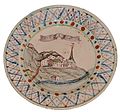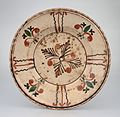St. Antönien pottery
The St.Antönien ceramic (after the potters also Lötscher ceramic was called) in St. Antönien Ascharina in Switzerland produced. Alongside Chur , Parpan , Davos and Tavetsch (hamlet Bugnei), St. Antönien was one of the more important ceramic production sites in the canton of Graubünden in the 19th century.
The potter of St. Antönien
Classically, Graubünden is not a land of stoners or potters. The bulk of the tableware was imported from other regions of Switzerland, Germany or Italy. And yet there was an important production of ceramics and tiled stoves in the Walser settlement of St. Antönien in the Prättigau in the 19th century. For Graubünden, the Lötscher workshop, which has been in operation for five generations, was certainly the most important pottery company in terms of quality, functionality and beauty of the products in modern times.
Peter Lötscher (1750-1818)
Peter Lötscher (1750-1818) was the son of a farmer and carpenter from St. Antönien, hamlet Ronegg. He served, presumably because of difficult economic conditions in the parental home, from 1770 to 1783 with an interruption in Dutch services, a. a. in Ter Veere . After leaving, he married Dorothea Luck on June 1, 1784 in St. Antönien. After his return home, he arranged the economic family situation and bought both houses and stables of the Middle Rhonegga in Ascharina from his siblings (inheritance). Where he gained his experience as a stoner and where the glaze, ceramic and porcelain recipes in his surviving family book come from (from the Netherlands?) Is unclear. Since no signed ceramics have survived from him and a "PL" signed tile series from his house in Ronegg is painted using the technique of polychrome underglaze brush decoration with scenes in fashionable urban or aristocratic French clothing from the pre-revolutionary period of the 1780s, everyone is Speculation that he could have learned the pottery trade in Heimberg or Langnau in the canton of Bern is irrelevant.
On the basis of a contract from 1806 that has been received, it is certain that he will give his sons Hans Lötscher (1788–1848) and Andreas Lötscher a Maiensäss, land and workshop as well as the newly built upper house in Ronegg with all the accessories for the pottery - tools, equipment, distillery as well as raw materials (clay, silver and gold smoothness, red Huberde and copper ash ) - sold. However, he reserved the right to use the turntable, the small turntable and the kiln and agreed that his son Andreas would have to turn a fire dish twice a year for him on request. From this we can probably conclude that in addition to farming from the Lower House on Ronegg, he only worked part-time as a crockery or tile painter. The last entries in the family book about goods that he had given to tile carriers on credit come from the year 1815. Only a detailed stylistic analysis of all the preserved Lötscher tiled stoves could clarify whether Peter and Andreas had those stored in the Rätisches Museum in Chur in 1809 and 1811 dated tiled stoves for his son Hans and himself or they are independent products from Andreas Lötscher. Dated ceramics with a typical underglaze brush decoration have existed since 1807, although it is currently impossible to differentiate between the works of Peter Lötscher and his son Andreas Lötscher. Peter Lötscher died in 1818.
Andreas Lötscher (1787-1852)
Since both sons got married soon after taking over the pottery (Hans Lötscher - Maria Egli; Andreas Lötscher - Barbara Hartmann) it was only logical that Andreas Lötscher (1787–1852) had a new house in 1809/1810 "down by the stream and on the main path" Workshop built, today's post house in Ascharina. His brother Hans stayed on Ronegg and lived successfully from agriculture. Stylistically and technically (underglaze brush decor), Andreas Lötscher continued his father's ceramic tradition, but also produced tableware in the style and decor of the Hafner workshops in the Bregenzerwald (with Malhorn, barrel and bristle decor). A small number of tiled stoves from him have survived in the region today. The oldest is from 1822.
Christian Lötscher (1821–1880)
From 1843 at the latest it can be proven that Christian Lötscher (1821–1880) , married to Magdalena Buol, also worked as a stoner in St. Antönien, probably in the workshop of his father Andreas Lötscher. This year he signed two tiled stove tops with a turquoise green faience glaze. He is said to have spent the time of his pottery apprenticeship in Horgen on Lake Zurich and also got to know the paint squirrel and stencil decor with which he later decorated his tableware and his tiled stoves. A clay relief (medallion) from his house in St. Antönien, created in 1852 and signed by Christian Lötscher, focuses on the manufacture of tiled stoves as his main line of business. In the side shields, however, there are also coffee dishes and double-handled pots and under the oven the pointed twisting bar as a typical handicraft symbol of a potter. When he took over the workshop, the form and decor language of the dishes from St. Antönien changed again. From this point on, crockery with a white basic robe and Malhorn decor as well as vessels with a black-red or black-and-white basic robe were produced, among other things. a. Terrines with lids, teapots, lavabos, mugs, plates, bowls and large cream pots with two side button handles. The design language and, above all, the decors reacted to the increasing importation of black-ground ceramics, most of which probably came from Berneck in the St. Gallen Rhine Valley. The shapes of the vessels, especially the bowls, still show the shapes of the Bregenzerwald. Christian Lötscher was also known for his unusually large, incised larding pots, which could be closed with a flat lid. His tiled stoves with turquoise-green faience and yellow lead glazes as well as filling tiles with green stencil decoration or partially with relief overlays broke stylistically with the previous production line of his father and grandfather. He also produced animal and soldier figures with plaster models. He decorated the tiled stove of the Landammann von Seewis in 1850 with a large cow. He introduced tube production in St. Antönien and also pressed stove tiles with his new tube press. Tubes and other objects were marked with a single-line stamp, which always has three mirror-inverted "N" as a trademark.
Peter Lötscher the Elder J. (1845-1894)
Between 1867 and 1871 Peter Lötscher the Elder took over . J. (born March 13, 1845, died June 4, 1894) took over the workshop. No signed ceramics by him are known, but there are tubes which, in addition to the usual ST.ANTONIEN stamp, also bear a seal “PL”. Peter Lötscher emigrated to America with his family and his cousin Peter Lötscher, a miller, in 1871. They reached New Orleans on April 1, 1871, by ship Hanover from Bremen. Peter lived with his family until his violent death in Conway, Arkansas, where he and his wife are also buried. A few years later, his cousin Peter moved to Dubuque, Iowa, where he worked in the furniture company of another relative, Christian Lötscher. Since the younger brother Andreas Lötscher was still too young, father Christian Lötscher had to take over the workshop again. He worked until at least 1879, as numerous dated ceramics are known from this year.
Andreas Lötscher d. J. (1857-1933)
The last potter in St. Antönien, governor Andreas Lötscher d. J. (1857–1933) took over the pottery after his father's death in 1880. He can only be assigned six cream harbors, dated 1891, with a white robe and two carrying buttons, which are entirely in the tradition of his father. Otherwise he mainly produced water pipes and ceased operations in 1898 for economic reasons. A flood in 1910 destroyed the remains of the workshop.
The Lötscher project
In the summer of 2017, a systematic, scientific study of household ceramics and the tiled stoves in this workshop, which is so important for Graubünden, will start: the Lötscher project . In April 2019 the Rhaetian Museum in Chur is showing a special exhibition on the subject. A two-volume monograph on the topic is being published on this occasion.
Lötscher ceramics are also presented in the St. Antönien local museum .
literature
- Andreas Heege: Lötscher's tiles. The Hafner from St. Antönien GR. In: Archeology Switzerland-Archeology Suisse-Archeologia Svizzera 41, Issue 4, 2018, 4–15.
- Andreas Heege: The Hafner Lötscher from St. Antönien - a cultural-historical research project on a rural craft business of the 19th century in a Walser settlement in Prättigau. In: Walser Mitteilungen 67, 2017, 7–11.
- Andreas Heege: The Hafner Lötscher from St. Antönien. A unique story about ceramics. In: Terra Grischuna 76, 2017, issue 6, 55-57.
- A. Heege: The excavations on the church hill of Bendern, municipality of Gamprin, Principality of Liechtenstein. Vol. 2: Tableware from the 12th to the 20th century. Vaduz 2016, pp. 40–58.
- A. Heege: The Lötscher family's pottery in St. Antönien in Prättigau, Graubünden, Switzerland. In: Hans-Georg Stephan: Ceramics and pottery in the 15./16. Century. Contributions to the 47th International Symposium for Ceramics Research from September 8 to 12, 2014 in Lutherstadt Wittenberg (= Hallesche Contributions to Medieval Archeology. Volume 2). Hall 2016, 72–78.
- F. Pieth: The pottery in St. Antönien. In: The Free Rätier 275, 1907.
- H. Lehmann: St. Antönien dishes. In: Yearbook of the Swiss National Museum 19, 1910, 44–47.
- Chr. Simonett: Peter Lötscher the founder of the pottery in St. Antönien. In: Bündner monthly newspaper. Journal of Graubünden history, local history and folklore 1974, issue 3/4, 81–103.
- R. Schnyder: Graubünden ceramics, glass and lava stone trades. In: Hans Erb: The Rätisches Museum, a mirror of Bündens culture and history. Chur 1979, 328-347.
Web links
- Lötscher ceramics in CERAMICA CH -National ceramics inventory of Switzerland (1500-1950)
- / Ceramics in Graubünden
- / Lötscher Terracotta Object of the Month in the Rhaetian Museum
- / Lötscher project goes TV
- / The Lötscher project, help out!
- Otto Clavuot: Lötscher. In: Historical Lexicon of Switzerland . (partially obsolete)
- / Ceramic collection in the St. Antönien local museum
- / Pottery from St. Antönien in Cambridge
- / Ceramics from St. Antönien in the web collection of the Swiss National Museum
- / The Rhaetian Museum in Chur has the largest ceramic collection from St. Antönien
- / Ceramics is also home to the Rosengarten cultural center in Grüsch
Individual evidence
- ↑ New Orleans Passenger Lists 1813-1963, registered as "Peter lollipops, Switzerland, brick maker"
- ↑ http://www.eclecticatbest.com/2013/07/misfortune-befalls-german-vintner-in.html
- ↑ http://www.findagrave.com/cgi-bin/fg.cgi?page=gr&GRid=101201665
- ↑ http://www.findagrave.com/cgi-bin/fg.cgi?page=gr&GRid=101201626











